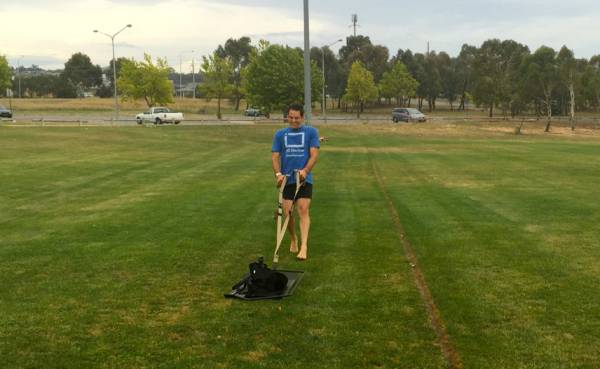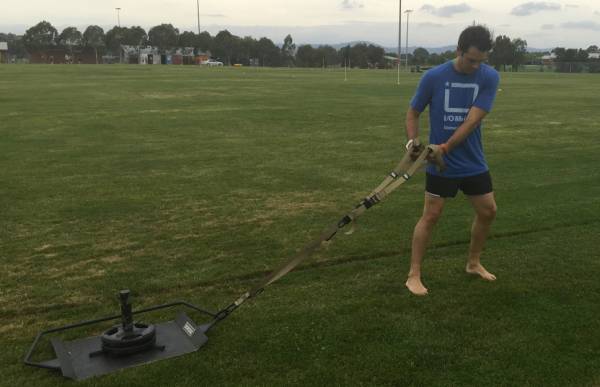Sled training is a highly effective and fun training modality for general conditioning and athlete-specific programming. This article will give you an overview of sled training, the associated benefits, and tips on how to effectively program the sled into your training.
That’s me doing a forward sled drag.
Sled Training Origins
While relatively new within the mainstream fitness industry, sled training has been around for quite some time. Drawing its inspiration from Scandinavian loggers who developed powerful legs and lower backs from dragging downed trees out of forests all day, the first commercial sleds starting appearing around 2005.
The most ubiquitous of these, the Prowler, was initially designed to enhance the sport-specific conditioning of American football linemen. Soon after, the Prowler and its variations began appearing in gyms around the world. These days, you will find sleds being utilized for interval training, speed training, strongman training, fat-loss conditioning, and general cardiovascular conditioning.
“The versatility of the sled allows you to program a number of different workouts to target specific muscular benefits, energy system development, or general conditioning.”
There are a variety of different sled models, but they all have the same general commonality: they can be dragged, pushed, or pulled and have the ability to add weights to provide extra resistance. Some models (e.g. the Prowler) have vertical posts on which weights can be loaded that also allow the sled to be pushed, while all models feature attachment points for towing straps. The versatility of the sled allows you to program a number of different workouts to target specific muscular benefits, energy system development, or general conditioning.
Sled Training Key Benefits
1. No Eccentric Loading
Without a doubt, the key benefit of using a sled is the lack of eccentric loading. As you probably know, eccentric loading (the negative part of a movement) generates large amounts of muscular tension, causing muscular damage and soreness.
Sled training won’t give you the same muscular and hormonal beatdown that traditional strength training does, allowing you to program it on a regular basis without interfering with other training elements. Be warned, though, even without the eccentric element, sled training still provides a brutally difficult workout.
2. Improves Acceleration
Acceleration is crucial to many sports. Sled training allows you to load traditional sprint-style work without interfering too much with the sprint mechanics. Loaded sprinting forces the body to work harder and recruit more musculature, leading to notable power and speed improvements. There is some good research demonstrating the benefit of sled training on sprinting times compared to just sprinting alone.
3. Functional Strength and Conditioning
When I say functional, I’m referring to the ability to manipulate sled training to deliver many different muscular or energy system training effects. Try some light sled drags or sprints to build acceleration and speed, heavy maximal sled pulls for lower-body strength boosts, or heavy sled pulls for time for muscular and cardiovascular strength-endurance benefits. As most sports or fitness activities require you to overcome resistance during movement (e.g. bodyweight or external resistance), sled training has useful transfer to sport

Backward sled drag
4. Reduced Joint and Muscle Loading
The heavy nature of the sled will limit you to low-speed and/or low-duration efforts. This by nature reduces the loading on the joints and muscles. This is of particular interest to distance runners and other endurance athletes as it provides a means of conditioning without beating your body down or requiring huge periods of recovery.
5. Injury Prevention and Rehabilitation
The lack of eccentrics and joint loading that comes from sled training make it ideal for injury prevention or rehabilitation training for lower-body focused athletes. I have personally used it as my primary form of running-specific training and conditioning when coming back from knee surgery three years ago. I highly recommend the same for anyone coming back from knee, ankle, or hip injuries.
6. Variety and Fun
Whether you’re an athlete or a weekend warrior, sled training offers something different from normal training methods. While challenging, it also adds a truly unique element of fun and variety to your training.
How to Use a Sled
As mentioned earlier, you can push, pull or drag a sled. As a point of reference, forward drags and pushes are useful for speed work (e.g. sprinting) and primarily target the posterior chain, while backward sled drags or pulls are brutal on the quadriceps. Sleds also provide the ability for lateral drags or pulls, which are fantastic for targeting the often-underutilized key muscles of the hip musculature.
In terms of harnesses, I recommend using a vest-based system for all forward drags and pulls and a TRX or something similar for all backward or lateral drags and pulls.
How Heavy Should My Sled Be?
There is no set rule on this and the research is still evolving, so it depends on your programming goals. Generally, the lighter the sled, the more you will focus on acceleration and speed-based benefits. Heavier sleds will focus you on maximum strength and/or strength-endurance benefits. As a rule of thumb, aim for 10-15% sled weight for acceleration work and up to 40-45% sled weight for more strength-based outcomes.

Lateral sled drag
Sled Training and Endurance Athletes
For endurance athletes, particularly runners, a strength/power session blended with some lactate tolerance work makes for a great running session substitution. I particularly recommend it early in the season or during a base phase instead of long run or slow-paced run to get in some quality strength and cardiovascular work.
Kyle’s Everyman Sled Protocol
Here’s my go-to sled workout to get you started. It starts with some strength/power alactic-based protocols that gradually morph into focusing on lactate tolerance as the session progresses and finishes. It also incorporates multi-planar movement for strengthening running gait in all directions.
Load sled to 40-45% of bodyweight.
Repeat A1-A4 for four rounds in total:
- A1. Forward drag 15-seconds maximum effort, 2min rest
- A2. Backward drag 15-seconds maximum effort, 2min rest
- A3. Lateral left drag 15-seconds maximum effort, 2min rest
- A4. Lateral right drag 15-seconds maximum effort, 2mins rest
Unload Sled for B + C
- B. Forward drag 60 seconds maximum effort with unloaded sled, 2min, rest
- C. Backward drag 60 seconds maximum effort with unloaded sled
Try this workout and report back, as well as suggesting any other effective protocols you’ve tried in the comments below.
Further Reading:
- Weighted Sled Tows Improve Sprint Performance Over Sprinting Alone
- Chris Duffin Video: Sled Pull-Through
- Science Investigates Optimal Loads for Sled Pulls
- What’s New on Breaking Muscle Today
References:
1. Lockie, Robert G. et al. “The Effects of Different Speed Training Protocols on Sprint Acceleration Kinematics and Muscle Strength and Power in Field Sport Athletes“; Journal of Strength and Conditoning Research; June 2012.






